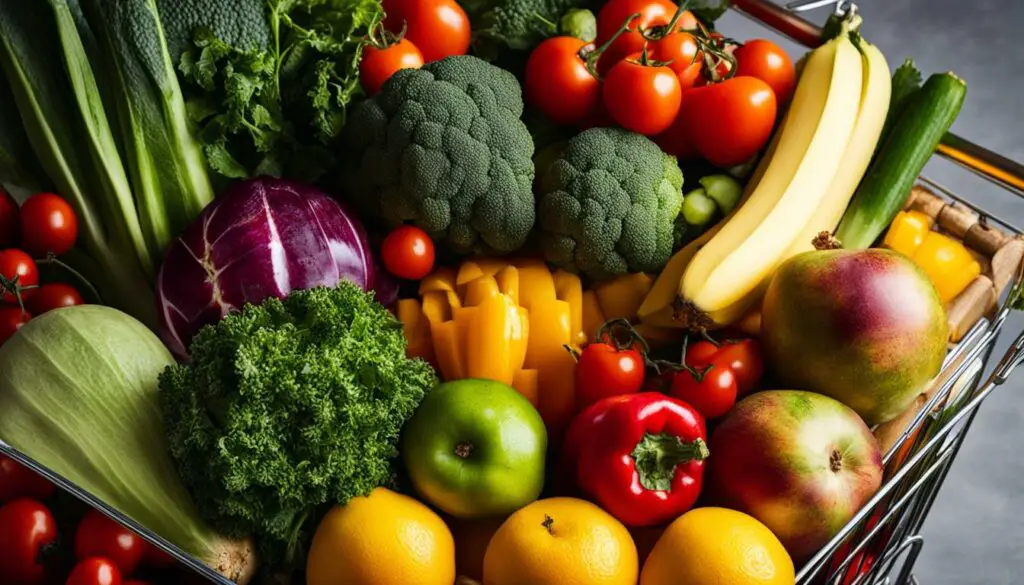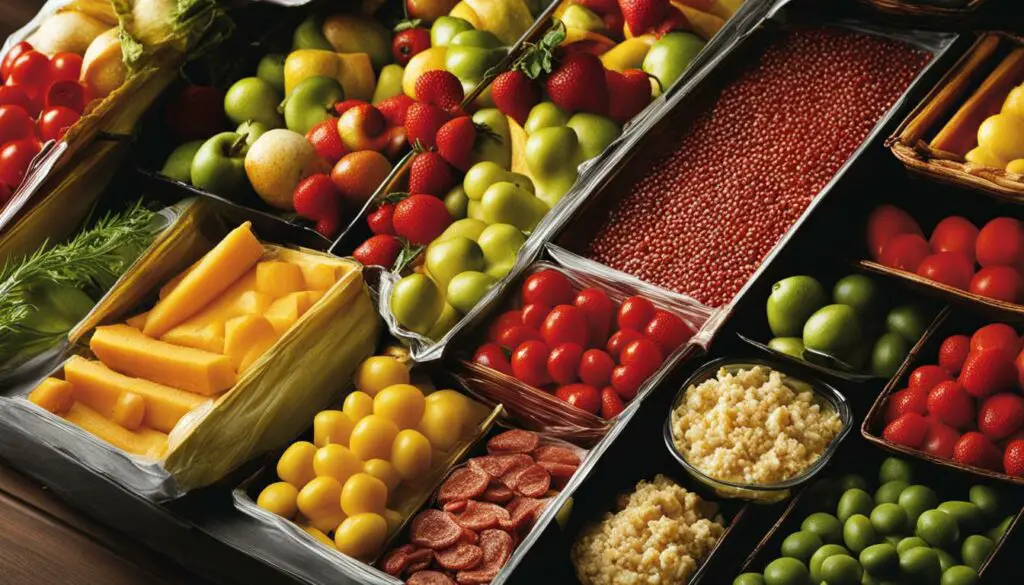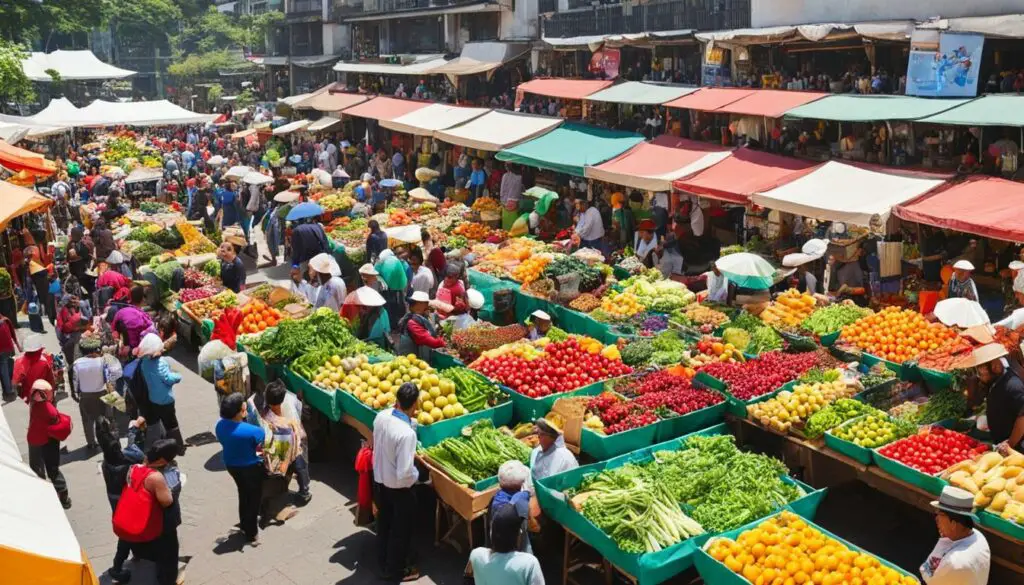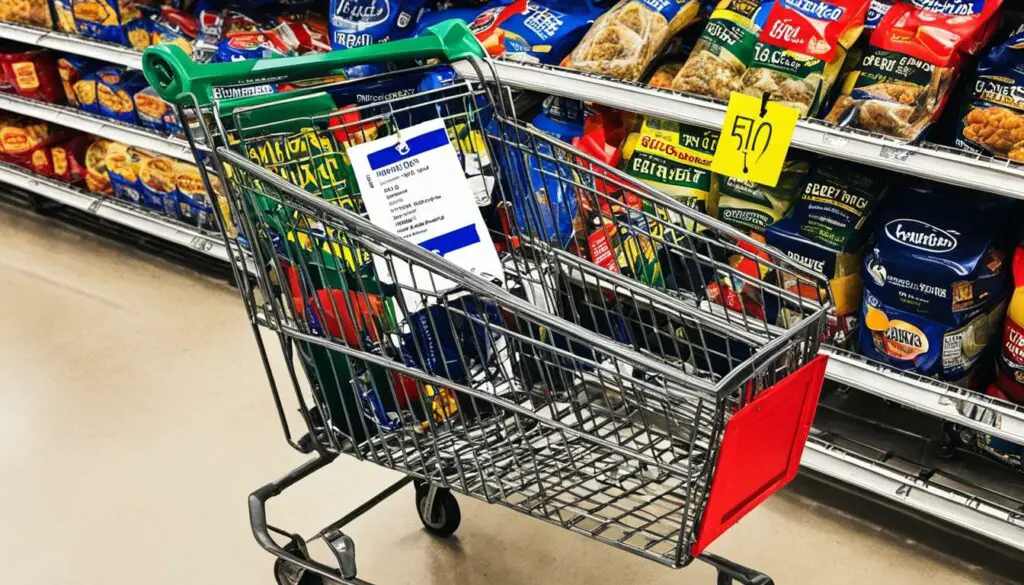Originally posted on December 20, 2023 @ 4:31 pm
According to the USDA Food and Nutrition Service (FNS), there are certain items that individuals and households cannot purchase with SNAP benefits, also known as food stamps. These restrictions are in place to ensure that SNAP benefits are used for essential and nutritious food items. It is important to know what can and cannot be bought with food stamps to make informed decisions while shopping.
Table of Contents
Key Takeaways:
- SNAP benefits can only be used to purchase eligible food items that are essential for a household.
- Prohibited items with SNAP benefits include alcohol, tobacco products, vitamins and supplements, live animals (except for certain exceptions), hot foods, and non-food items such as cleaning supplies and hygiene items.
- SNAP benefits are distributed through an electronic benefits transfer (EBT) card and can be used at participating retailers.
- While SNAP benefits cannot be used for non-eligible items, there are other ways to save on these items, such as choosing store brands, using coupons, and taking advantage of sales and discounts.
- Individuals can check their SNAP balance and eligibility through various methods, such as the state’s EBT website or mobile app.
Eligible Food Items for SNAP Purchase

SNAP benefits provide individuals and households with the means to purchase a variety of essential food items. The United States Department of Agriculture (USDA) has outlined the eligible food items that can be purchased using SNAP benefits. These include:
- Fruits and vegetables: SNAP recipients can use their benefits to buy fresh or frozen fruits and vegetables, ensuring access to nutritious produce for a balanced diet.
- Meat and poultry: SNAP benefits can be used to purchase meat and poultry, allowing individuals and families to incorporate protein-rich options into their meals.
- Dairy products: Eligible dairy products such as milk, cheese, and yogurt are available for purchase with SNAP benefits, providing a source of calcium and other essential nutrients.
- Breads and cereals: SNAP recipients can buy bread, cereal, pasta, and rice to meet their carbohydrate needs and maintain a well-rounded diet.
- Snack foods: Certain snack foods, such as chips and cookies, are also eligible for purchase with SNAP benefits, providing individuals with options for occasional treats.
- Non-alcoholic beverages: SNAP benefits can be used to buy non-alcoholic beverages such as fruit juices, tea, and coffee, ensuring hydration options for households.
- Seeds and plants: SNAP recipients can even use their benefits to buy seeds and plants that produce food, enabling them to grow their own fruits and vegetables.
These eligible food items offer a range of choices for individuals and households to maintain a balanced and nutritious diet while using their SNAP benefits. By including a variety of food groups, SNAP ensures that recipients can access the essential nutrients they need for their overall well-being.
Check out the table below for a comprehensive overview of eligible food items for SNAP purchase:
| Food Category | Examples |
|---|---|
| Fruits and Vegetables | Fresh apples, frozen broccoli, canned peaches |
| Meat and Poultry | Ground beef, chicken breasts, pork chops |
| Dairy Products | Milk, cheese, yogurt |
| Breads and Cereals | Whole wheat bread, oatmeal, rice |
| Snack Foods | Chips, cookies, popcorn |
| Non-Alcoholic Beverages | Fruit juice, tea, coffee |
| Seeds and Plants | Tomato plants, cucumber seeds |
With this wide range of eligible food items, SNAP benefits aim to provide recipients with the means to access nutritious and essential foods for themselves and their households.
Prohibited Purchases with SNAP Benefits

While SNAP benefits provide essential assistance for purchasing food, there are certain items that cannot be bought with food stamps. These restrictions are in place to ensure that SNAP benefits are used solely for necessary and nutritious food items. It’s important to familiarize yourself with the prohibited purchases to make informed decisions while shopping.
What Can’t You Buy with Food Stamps?
Here is a list of items that are prohibited from being purchased with SNAP benefits:
- Alcohol: SNAP benefits cannot be used to buy any form of alcohol, including beer, wine, or spirits.
- Tobacco Products: Cigarettes, cigars, chewing tobacco, and any other tobacco products are not eligible for purchase with SNAP benefits.
- Vitamins and Supplements: Non-prescription vitamins and dietary supplements are not considered essential food items and are therefore ineligible for purchase with SNAP benefits.
- Live Animals: With the exception of certain exceptions, SNAP benefits cannot be used to buy live animals, including pets or livestock.
- Hot Foods: Prepared foods that are meant to be eaten immediately, such as hot deli meals or food from a restaurant, are not eligible for purchase with SNAP benefits.
- Non-Food Items: SNAP benefits cannot be used to buy non-food items, such as cleaning supplies, personal hygiene items, pet food, or any other products that are not considered essential food items.
Understanding these restrictions will ensure that SNAP benefits are used appropriately and solely for purchasing essential food items.
It’s important to note that SNAP benefits are intended to provide support specifically for purchasing essential food items. By adhering to these restrictions, we can ensure that the program continues to fulfill its purpose and help individuals and families in need.
How SNAP Benefits Are Distributed

SNAP benefits, also known as food stamps, are distributed through an electronic benefits transfer (EBT) card. This card functions like a debit card and allows eligible individuals and households to purchase essential food items.
The EBT card can be used at participating retailers such as grocery stores, supermarkets, and superstores. This means that you can conveniently use your SNAP benefits to buy groceries from your local store.
Additionally, the EBT card can also be used at local food co-ops, where you can find a variety of fresh and locally sourced food items. Supporting local farmers and businesses while using your food stamps is a great way to contribute to your community.
Another exciting option is the ability to use your EBT card at farmers markets. Farmers markets provide a wide range of fresh fruits, vegetables, and other food products. The interactive and vibrant atmosphere of farmers markets allows you to connect directly with local farmers while selecting your purchases.
With the increasing popularity of online shopping, certain areas also enable online purchases using the EBT card. This provides a convenient and accessible way for eligible individuals to shop for groceries from the comfort of their own homes.
Overall, the distribution of SNAP benefits through the EBT card offers flexibility and accessibility in purchasing eligible food items. Whether you prefer shopping at local stores, farmers markets, or online retailers, the EBT card ensures that you can make use of your SNAP benefits at participating locations.
Other Ways to Save on Non-Eligible Items

While SNAP benefits cannot be used to purchase non-eligible items, there are still ways to save on these items and stretch your grocery budget. Here are some tips on how you can save money when buying items that are not covered by food stamps:
1. Choose Store Brands
Opting for store brands instead of name brand items is a great way to save money. Store brands often offer similar quality at a lower price, allowing you to get more value for your money.
2. Use Coupons
Coupons can be a fantastic way to save on non-eligible items. Look for coupons in newspapers, magazines, and online platforms. Many stores also have their own digital coupon programs that you can sign up for. Simply present the coupons at checkout to take advantage of the discounts.
3. Sign Up for Loyalty Programs
Many grocery stores offer loyalty programs that provide exclusive discounts and rewards to members. By signing up for these programs, you can access special deals on non-eligible items and accumulate points towards future savings.
4. Take Advantage of Sales and Discounts
Keep an eye out for sales and discounts on non-eligible items. Stores often have weekly or monthly promotions where you can get these items at a reduced price. Planning your shopping around these sales can help you save a significant amount of money.
“Choosing store brands, using coupons, signing up for loyalty programs, and shopping during sales are all effective ways to save on non-eligible items and maximize your grocery budget.”
– Mary Johnson, frugal living expert
By implementing these money-saving strategies, you can make your grocery budget go further and save on non-eligible items. Remember to always compare prices, look for discounts, and make informed choices to make the most of your shopping experience.
Comparison of Prices
| Item | Name Brand Price | Store Brand Price | Savings |
|---|---|---|---|
| Milk | $3.99 | $2.99 | $1.00 |
| Pasta | $1.79 | $0.99 | $0.80 |
| Snack Chips | $2.49 | $1.49 | $1.00 |
The table above showcases the potential savings when choosing store brands compared to name brands. By opting for store brands, you can save a significant amount of money on everyday items. These savings can add up over time and have a positive impact on your grocery budget.
Checking SNAP Balance and Eligibility

As a SNAP recipient, it is crucial to stay informed about your SNAP balance to effectively plan your purchases. There are several ways to check your SNAP balance:
- Last Store Receipt: After each transaction, your remaining SNAP balance will be printed on the bottom of your store receipt.
- EBT Website or Mobile App: Many states provide online access or mobile apps where you can check your SNAP balance anytime, anywhere.
- Customer Service Line: Get in touch with the customer service line for your state’s SNAP program to inquire about your balance over the phone.
Checking your SNAP balance allows you to have a clear understanding of how much assistance you have available to ensure you can provide nutritious meals for yourself and your family.
Determining SNAP Eligibility
If you are interested in applying for SNAP benefits, there are several resources available to help you determine your eligibility:
- Pre-Screening Tool: The USDA offers an online pre-screening tool that can assess your eligibility for SNAP benefits. By answering a few simple questions, you can quickly determine if you meet the initial qualifications.
- Work Requirements: Understanding the work requirements for SNAP benefits is essential. Different states may have different guidelines, so it’s crucial to familiarize yourself with the specific requirements in your state.
- Local SNAP Office: To gain a more thorough understanding of SNAP eligibility and the application process, consider visiting your local SNAP office. Knowledgeable staff will guide you through the requirements and assist you in completing the application.
- Application Process: Applying for SNAP benefits typically involves completing an application form, providing necessary documentation, and attending an interview. It is important to be prepared and organized during this process to ensure a smooth application experience.
By utilizing these resources, you can determine your SNAP eligibility and take the necessary steps to apply for and receive the assistance you need.
State-Specific SNAP Rules
https://www.youtube.com/watch?v=mr4QZVb6j94
While SNAP benefits have general rules at the federal level, it’s essential to understand that each state may have its own specific rules and exceptions. It’s crucial to be aware of these state-specific regulations to ensure you are using your SNAP benefits appropriately.
Special Exceptions: Alaska Hunting and Fishing Equipment
One noteworthy example of a state-specific rule can be found in Alaska. In Alaska, SNAP benefits can be used to purchase hunting and fishing equipment if the intention is to use it to feed the household. This is a special exception that recognizes the unique hunting and fishing practices that are vital for subsistence in the state.
| State | Special Rules and Exceptions |
|---|---|
| Alaska | SNAP benefits can be used to purchase hunting and fishing equipment if it is intended to feed the household. |
| Texas | SNAP benefits cannot be used to purchase energy drinks. |
| New York | SNAP benefits can be used to purchase prepared meals from certain authorized retailers. |
| California | SNAP benefits cannot be used to purchase hot food items from fast food restaurants. |
| Florida | SNAP benefits can be used to purchase seeds and plants that produce food for the household. |
As seen in the table above, each state may have its own specific rules and exceptions when it comes to SNAP benefit usage. It’s important to familiarize yourself with these regulations to avoid any misuse of benefits and ensure that you are making eligible purchases.
Being knowledgeable about state-specific SNAP rules allows individuals and households to make the most of their benefits and make informed decisions while grocery shopping.
Conclusion
Understanding the restrictions on what can be purchased with SNAP benefits is crucial for individuals and households to make informed choices while shopping. By familiarizing themselves with the eligible and non-eligible items, SNAP recipients can effectively utilize their benefits to purchase nutritious and essential food items for their families.
It is important to remember that SNAP benefits cannot be used to buy prohibited items such as alcohol, tobacco products, vitamins and supplements, live animals, hot foods, and non-food items. However, recipients can still find ways to save on non-eligible items by opting for store brands, using coupons, signing up for loyalty programs, and taking advantage of sales and discounts.
By understanding SNAP restrictions and making informed choices, individuals and households can make the most of their grocery budget. It is also advisable to stay informed about the specific rules in your state, as there may be special exceptions or additional restrictions that apply.
FAQ
What items can’t be purchased with food stamps?
Certain items cannot be purchased with SNAP benefits, including alcohol, tobacco products, vitamins and supplements, live animals (except for certain exceptions), hot foods, and non-food items such as cleaning supplies and hygiene items.
What food items are eligible for SNAP purchase?
Eligible food items for SNAP purchase include fruits and vegetables, meat, poultry, dairy products, breads and cereals, snack foods, non-alcoholic beverages, and even seeds and plants that produce food for the household.
How are SNAP benefits distributed?
SNAP benefits are distributed through an electronic benefits transfer (EBT) card, which can be used at participating retailers such as grocery stores, supermarkets, superstores, local food co-ops, farmers markets, and even online retailers in certain areas.
How can I save on non-eligible items?
To save on non-eligible items, consider choosing store brands instead of name brand items, using coupons, signing up for loyalty programs, and taking advantage of sales and discounts offered by retailers.
How can I check my SNAP balance and eligibility?
SNAP balances can be checked on the last store receipt, through the state’s EBT website or mobile app, or by contacting the customer service line for the state’s SNAP program. Individuals interested in applying for SNAP benefits can use the USDA’s online pre-screening tool, check for work requirements, visit their local SNAP office, or complete an application to determine their eligibility.
Are there state-specific rules for SNAP benefits?
Yes, each state may have its own specific rules and exceptions regarding SNAP benefits. For example, in Alaska, SNAP benefits can be used to purchase hunting and fishing equipment if the intention is to use it to feed the household. It is important to be aware of the state-specific rules when using SNAP benefits.
Source Links
- https://www.fns.usda.gov/snap/eligible-food-items
- https://finmasters.com/what-can-i-buy-with-snap/
- https://www.gobankingrates.com/saving-money/food/food-stamps-what-you-can-and-cant-buy-with-snap-benefits/
See also:
Leave a Reply